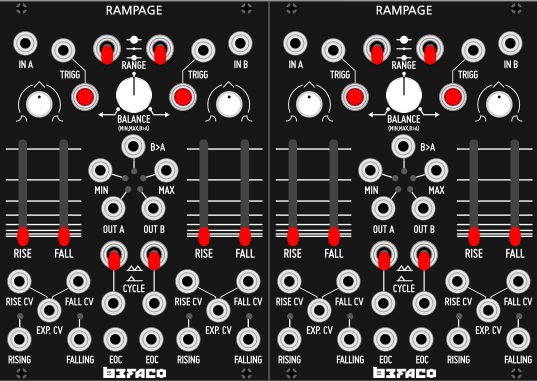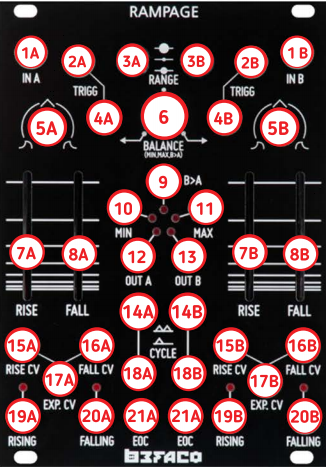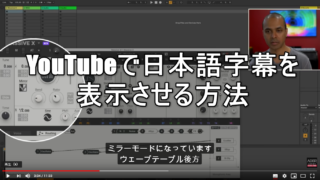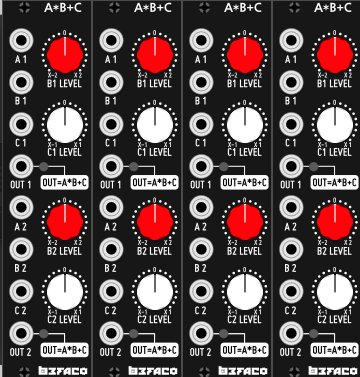How to use VCV Rack Explanation of Befaco Rampage

This is yosi from Chillout with Beats.
VCV RackThis is a description of the module Befaco Rampage.
Modular debut is still a long way off, but I'm busy preparing for it.
There was a video on the official, so I will paste it.
The price is 326,00 € for the pre-assembled and 195,00 € for the DIY kit.
All are in English, but there is a way to display Japanese subtitles.
Please refer to the following article for how to display Japanese subtitles.
What is VCV Rack Befaco Rampage?
Rampage, Befaco's approach to the old invention, the Serge / Buchla lamp generator.
The above is Google Translate, but the point is that when Befaco makes a lamp generator, it will be like this!I think that's what it means. (Roughly)
However, there was the following description as an application of the lamp generator.
Anyway, it is multifunctional and seems to be an excellent one that can be used as a VCO, LFO, filter as well as an envelope.
-Voltage controlled Attack Decay envelope.
-Attack Sustain Release Envelope.
-More complex ADSR Style Envelope.
-Dual VCO. With Square, PWM, Saw, Log, Exp and Triangle shapes. Hard and soft sync.
-Gated VCOs
-VCO + Analog AND Gate (As ADTimbral VCA)
-Dual Low Pass Filter
-Dual Low pass Filter with VCO soft sync.
-Low Pass Filter + AD Envelope
-Dual “syncable” voltage controlled LFO with Square, PWM, Saw and Triangle shapes)
-Complex LFO. Function combination.
-CV controlled and “Ping-Pong” LFO.
-Dual Slope detector. Distinguishes when and incoming signal (CV or audio) is rising or falling, and generates gates in concordance.
-Comparator. Send a gate when B IN is bigger than A IN
-Polyrythmic gate generator. With both channels synced between each other, it generates several “complex rhythm” gates.
-Voltage controlled Slew limiter with independent attack and decay control and continuous variable shape between Log, linear and expo.
-Peak Voltage follower. Max Out follow the maximum Level of the two inputs.
-Minimum Voltage Follower. Min Out follow the minimum level of the two inputs
-Envelope follower with adjustable response for rising ans falling flanks.
-Voltage controlled Trigger Delay.
-Burst Generator.
It's been a while since I've come to a guy who can't tell at all just by touching it.
Features of VCV Rack Befaco Rampage

1A / 1B Main Input: Now connect the signal you want to process (CV or audio).Insert the gate signal into the AD (Attack-Decay) envelope of the sustain (same sustain level) as your gate signal.
2A / 2B Trigger Input: Starts the internal function generator.
3A / 3B Range Selector Switches: Choose from 3 different working speeds.
1. High (small dots): Use this speed for audio speed applications and fast processing.
2. Medium (medium dot): This is the rate for envelopes.
3. Low: (Large Dot): LFO-like application and loooong envelope
4A / B Manual Trigger Buttons: Push to manually initialize the internal function generator
5A / B Shape Controls: Change the response of the integrator from an exponential function to either.Linear or logarithmic.
6 Balance Controls: A and B before going to the mix section, which acts as a crossfader for signal levels from the channel.This parameter only affects the output of A> B (9), MIN (10), and MAX (11).It does not affect OUT A and B (12 and 13).
7A / B Rise Controls: These are manual controls for rise time.Fader up = longer rise time.When using a "cycle mode" or device as a lowpass filter, the frequency drops when CYCLE (14A / B) is on, in inverse proportion (opposite), assuming time and frequency are related.
8A / B Fall Controls: It has the same operating principle as Rise Controls, but it has a fall suppression time.
9A / B Comparator Output: If the output of channel B is larger than the output of channel A, 10V is output.
10 Minimum Output: AKA "Analog AND".It compares the outputs of both channels and always outputs the minimum value.
11 Maximum Output: AKA "Analog OR".It compares the outputs of both channels and always outputs the maximum value.Sometimes this is also called a "peak follower".
12-13A / B Main Outputs: Main output of channels A and A
14A / B Cycle Switches: Choose from two modes of operation.
1. "One Shot": Stops when the fall ramp reaches 0 volt.Use this mode for envelope generation
2. “Cycle”: This mode acts as a function generator.When the fall ramp reaches 0 volt, it will trigger again.
– Use "cycle" mode for wave generation (LFO or audio rate)
– “One Shot” and “Cycle” modes can only be retriggered during the fall state.
– In "Cycle" mode, TRIG and IN can be used as hard and soft.Synchronous input for each.
15A / B Rise CV Inputs: Remote control for rise time.It's an equivalent CV. RISE fader
16A / B Fall CV Inputs: Same as RISE CV, but for FALL faders.
17A / B Exponential CV Inputs: – Control RISE and FALL at the same time.This input reacts in the opposite direction of RISE / FALL.The higher the resume voltage, the shorter the time.Input is useful when using this inversion rampage as a filter or oscillator to control frequency or cutoff.
18A / B Cycle Gate Inputs: Invert the CYCLE switch. Rotate in "one-shot" mode It "circulates" and vice versa.For greater flexibility, the cycle gate input does not cause a rampage.Just put it in "Cycle" mode If you want to trigger it and make it a "cycle" mode at the same time (for gate LFO / VCO generation) send your gate TRIGG and CYCLE at the same time.
19A / B Rising Gate Inputs: These are the outputs of the slope detector.The output has a 10V gate rise every time.When using a slope detector For external signals, the speed should be adjusted to avoid lag processor unstable behavior with respect to the speed of the input signal.A function that uses a slope detector to extract a gate from an analog signal to detect changes, or to connect A and B rampage channels to generate a complex number.
20A / B Falling Gate Outputs: Same as RISING, but only works during Falling.
21A / B End of Cycle Outputs: A short 10V pulse is supplied for each internal function. The generator reaches 0V. EOC does not work with external signals.
How to use VCV Rack Befaco Rampage
There are some usage examples in the manual, so I will describe how to do it.
How to use Befaco Rampage as a VCO / LFO
– You can create a variety of waveforms by putting CYCLE in “cycle” mode.In the case of a square wave, simply take the output from the rise or fall.
– For triangle waves, move the RISE & FALL faders together to bring them to the same level and change the frequency.
– For sawtooth waves, use the RISE fader to a minimum. You can change the frequency with just the FALL fader.
– Other waveforms can be created by combining different SHAPE control knobs to adjust the fader position.
– For PWM pulses, use B> A as the output, use the voltage TRIGG to IN B to synchronize the waveform, and use IN to create and synchronize the software.
I didn't understand the explanation well, so I took a video.
The following videos are triangle waves and sawtooth waves.
I use it as a VOC, but if I raise RISE and FALL, it will be much slower, so I can use it as an LFO.
The following video shows the PWM pulse.
If you also use the A side, the sound will sound like it has been modulated.
How to generate a complex LFO with Befaco Rampage
Looking at the output from MAX and MIN with SCOPE, it seems that you can make a fairly complicated LFO.
Since MAX and MIN are synchronized, it seems that they can be used in various ways.

VCV Rack Befaco Rampage Summary
I think this is also overloaded with features, which would be nice for users.
I couldn't fully introduce it, but it seems that it can be used as a Low Pass filter or distortion.
Isn't it because it's an amateur who thinks it's cool if he can master this kind of thing?
At first, when there are few modules, I think we have to rely on multifunctional modules.



Comment